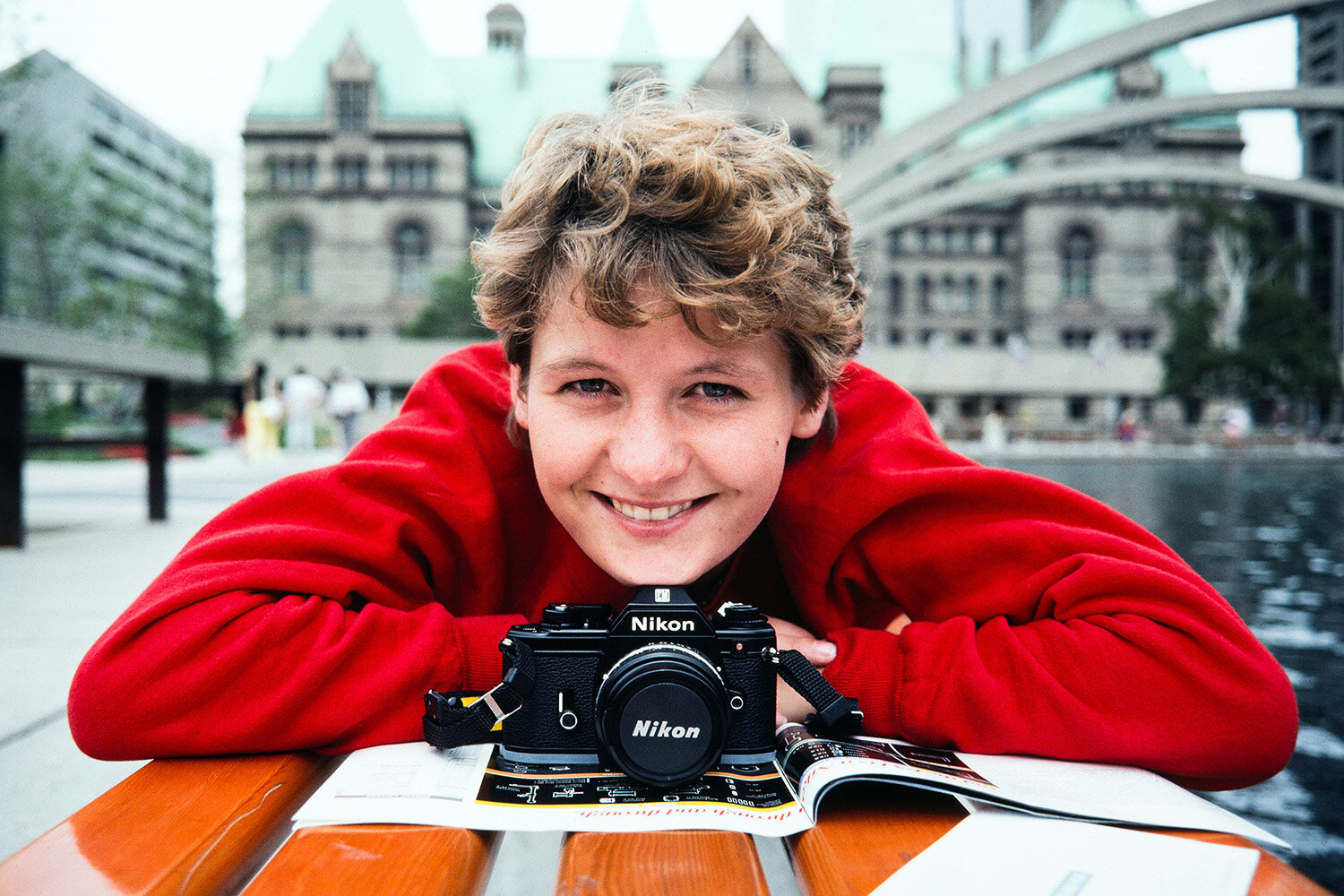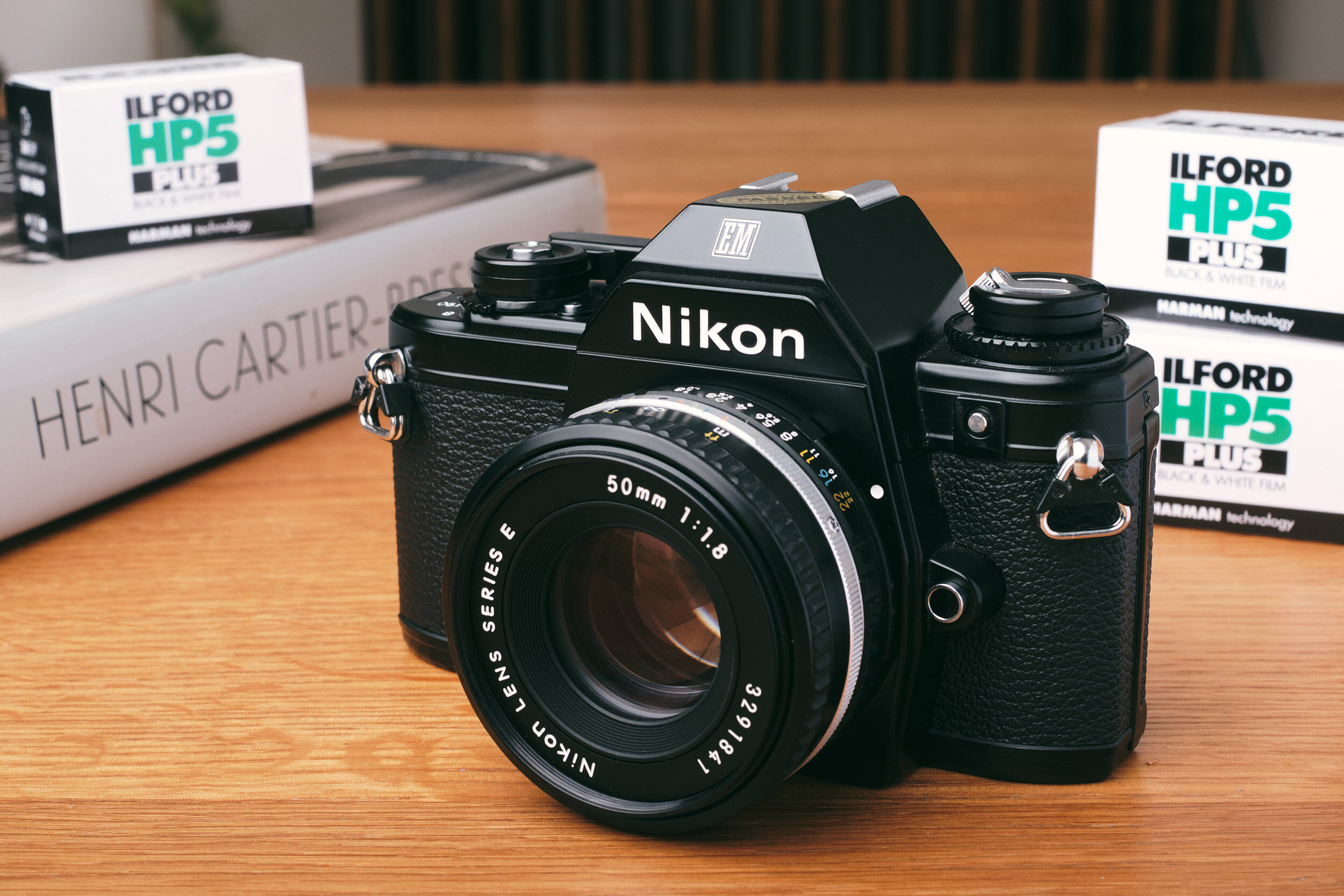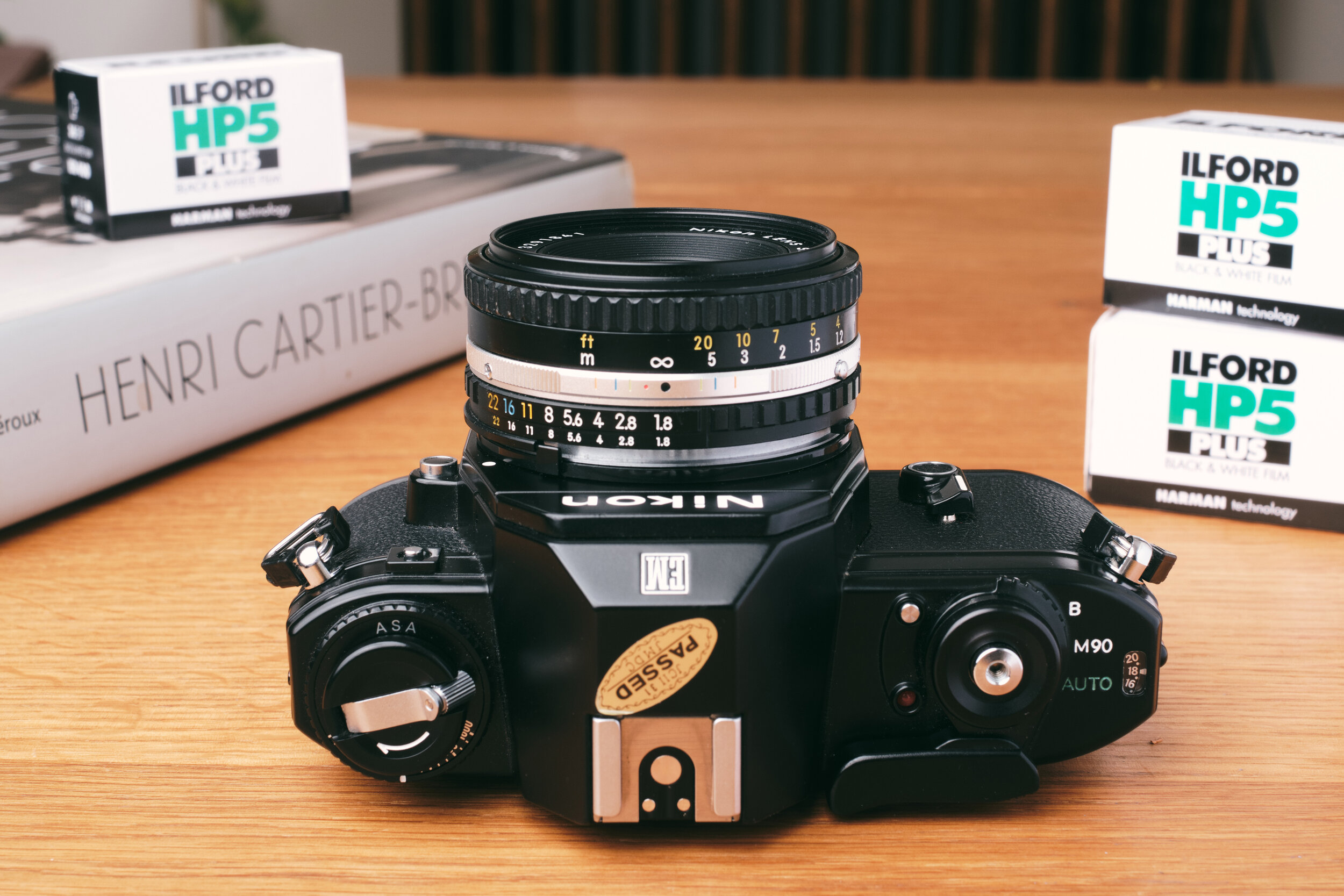Nikon EM Review

Diana in 1984, Toronto - Canada, with a brand new Nikon EM :)
Nikon EM - A Blast From the Past
For a while now, I have been toying with an idea. Over the years, I have owned more cameras than I care to admit. However, I was never a collector, meaning whenever a new camera sparked my interest, I sold the old model and put the money toward the new camera.
The improvements were usually incremental, but the newer cameras were always exciting, and the old were quickly forgotten. Some of the cameras I have owned stick out in my memory, and I have now set a goal to acquire some of these cameras again to see if my excitement will be reignited.
The Nikon EM shown with a Nikon 50mm f/1.8 Series E
The Nikon EM “SLR Camera For Women”
In 1979 the Nikon EM was introduced as an SLR camera for women and it was the cheapest SLR at the time. The idea was to give beginners an alternative to the more expensive options of higher-quality cameras from Nikon and to fend off competition from the likes of Canon, Minolta, and Olympus.
Imagine a campaign like that today. Nikon would most certainly be facing a social media storm. Apparently, the strategy did not work out in Nikon’s favor and the Nikon EM did not become a sales success.
I have to confess. This was not my camera but the camera we picked for Diana, my wife-to-be, on a summer day in Toronto in 1984.
After hanging out with her photo-buff boyfriend for almost a year, at the time, Di had little choice but to join the ranks as a photography enthusiast and hence ended up with the Nikon EM.
Diana in Lakeside, Ontario flashing a new Nikon EM, in the summer of ‘84. The photo was captured with a Canon AV-1.
Nikon EM in 2022
I had planned to get Diana a Nikon EM for Christmas (really a gift for myself) but the plan was ruined when I found a perfectly mint copy at Beau Photo here in Vancouver for CAD $40.00 (USD $30.00). How could I resist? When Di had the Nikon EM in 1984 it came with the very compact Nikon 50mm f/1.8 Series E lens.
This lens was made as an affordable yet good-quality alternative to the more expensive Nikkor line of lenses from Nikon.
A couple of weeks later I found a mint copy of the 50mm f/1.8E on Craigslist for CAD $100.00 (USD $75.00). I also found plenty of Nikon EM options on eBay and I am sure wherever you are in the world you can find one on the used market.
Nikon EM History and Specs
The Nikon EM was produced from 1979 to 1982 and was in stores until 1984. Little did we know but we must have snapped up one of the last available copies back in Toronto. Italian car designer Giorgetto Giugiaro is responsible for the striking design which to this day stands the test of time if you ask me.
The Nikon EM has shutter speeds ranging from 1 to 1/1000s with a 1/90s flash sync speed. On the M90 setting, the camera will operate without a battery at the 1/90s shutter speed and on the AUTO settings at 1/1000s.
The copper-aluminum-alloy compact body weighs 16.2 oz. / 460 g. The top and bottom covers are made from fiberglass-reinforced polycarbonate plastic. The camera only came in black.
The mode dial with AUTO, M90, and B settings. The shutter release button, film advance, and self-timer lever on the Nikon EM with a 50mm f/1.8 E.
The Nikon EM has 60/40 center-weighted metering and the needle pointer shows exposure times in the viewfinder which also has the split image focusing aid. The camera has three shooting modes. AUTO which is an aperture priority mode. You pick the aperture on the lens and the lightmeter suggests a shutter speed.
A manual mode gives you just one option for a shutter speed at 1/90s and finally bulb for long exposures. If you want to manually override the exposure, you can do so by adjusting your exposure using the ISO dial. Just make sure to put it back after taking a photo.
You also have the option to hit the backlight button on the front of the camera which will lower your shutter speed by two stops. Indeed a handy feature, typically for backlit portraits.
West End, Vancouver, Nikon EM, Nikon 50mm f/1.8 Series E. For this photo I did an exposure override and set the camera to ISO 200 when exposing an Ilford HP4 ISO 400 ISO film. I did so to make sure the eyes were exposed correctly.
Nikon EM, a 35mm Full-Frame Camera For $30.00
I know you cannot compare a Nikon EM to modern digital full-frame options but then again why not entertain the thought for a second?
At 16.2 oz. / 460 g the Nikon EM is about the same weight as my APS-C sensor mirrorless Fujifilm X-Pro3 and it has a smaller footprint. Full-frame digital cameras are often larger and autofocus lenses, in general, are larger also, and heavier.
I am in no way disregarding digital cameras here but merely stating the fact that for very little money you can enjoy the look of full-frame, 35mm photos and you will not have to worry about using digital film simulation in order to get the film look. It just comes with the territory :)
An evening stroll along English Bay in Vancouver with the Nikon EM. Photos by Mik Byskov on his iPhone 12 Pro Max.
Nikon EM in Action
It strikes me that even the cheapest SLR camera, such as the Nikon EM, from the late eighties/early nineties, feels so well made in comparison to today’s cameras. While you will see improvement in higher-priced cameras, the prism viewfinder is still easy to use for focusing and it is nice and big for framing your shots.
Being a left-eye shooter, I found it a bit hard to see the needlepoint exposure indicator which is placed on the left side of the viewfinder. Especially in darker conditions.
I love the looks and feel of the Nikon EM but found the size of the body almost too small for my hands. The fact that this camera does not have full manual exposure control could potentially put off some photographers.
I have shot aperture-priority since these cameras came out and love this setting. An exposure compensation dial would have been nice but having the ISO dial essentially gives you manual control to a certain degree.
Street Photography With the Nikon EM
The skies are grey and we predominantly have darker days here in November. I loaded the Nikon EM with a roll of Ilford HP5 Plus and headed out into the city. I found it satisfying having to wind the film for each frame and focusing was much easier than the Hasselblad 503CX I was testing a few weeks earlier.
My favorite lens with my Fujifilm X-Pro2 is the XF 35mm f/1.4 R (50mm full-frame equivalent), so I felt right at home shooting the Nikon EM with the Nikon 50mm f/1.8 Series E lens.
For black-and-white photography, I usually turn to Fujifilm’s Acros film simulation and I was eager to see how the Ilford HP5 stacked up against it.
East Vancouver, Nikon EM, Nikon 50mm f/1.8 Series E, Ilford HP5 Plus
Fujifilm’s Film Simulation vs. the Real Thing
Fujifilm’s black-and-white film simulations are indeed very good and I use them all the time for my Fujifilm X Series photos.
When taking a closer look at the photos taken with the Nikon EM and Ilford HP5 it looks more realistic. Perhaps because it is the real thing :) The Ilford HP5 film is at 400 ISO and the grain is quite pronounced and the tonality of the film really shows. I like it.
The negatives were copied using a Fujifilm X-Pro2, an AF Micro Nikkor 60mm f/2.8D lens, and the Skier Sunray Copybox 3.
The RAW files were imported into Lightroom and I used the Negative Lab Pro Lightroom Plugin to convert the files. I did very limited exposure and level adjustments in order to keep the files as close to reality as possible. For more sample images see below.
East Vancouver, Nikon EM, Nikon 50mm f/1.8 Series E
Nikon EM Conclusion
You may never have heard of the Nikon EM but if you are considering a camera to begin your journey with film photography I warmly recommend it. Although the Nikon EM was not a commercial success I would argue it was a success in other ways.
It still holds up today as an excellent camera and appears to be very durable, and very affordable. It would be an excellent first film camera for anybody.
I got a kick out of shooting this first roll and already have a roll of Kodak Gold loaded, a film I used to shoot a lot in days gone by.
The first thing that put people off about film photography is usually the price of film and the hassle of developing it but when you can start at such a low cost of entry I think the experience is worth every penny and I am quite happy with the results from my first roll with the Nikon EM.
Nikon EM, Nikon 50mm f/1.8 E, Ilford HP5 Sample Images
Update
Nikon EM and Kodak Gold 200 Sample Images
I have now had a chance to run a roll of Kodal Gold 200 through the Nikon EM and although the Gold 200 is regarded as a consumer-grade film with an affordable price I was pleased with the results.
Update: June 2022
Nikon EM, Voigtländer Ultron 40mm f/2 SL IIs, Ilford HP5 Sample Images
I have now had the chance to run a few more rolls of film through the Nikon EM and will share the sample images below captured at the Stand For Ukraine Rally in Vancouver, in March of 2022.
In this gallery I used the Nikon EM and a Voigtländer Ultron 40mm f/2 SL IIs on Ilford HP5 Plus.
I have a review of the Voigtländer lens here if you are interested:
Nikon EM, Nikkor 50mm f/1.4 AIS, Kodak Tri-X 100 Sample Images
In this next roll, I was using the Nikon EM with a classic Nikkor 50mm f/1.4 AI-S and Kodak Tri-X 100 black and white negative film. Note to self: Pick up more rolls of Tri-X. I really like this film stock with a fine grain and great tonality.
You can read a review of the Nikkor 50mm f/1.4 AI-S here:
The Nikon EM is still ticking along with no issues.
Nikon SLR and F-Mount Lens Reviews
Nikon F3
Nikon F
Nikon FM3a
Nikon FM2n
Nikon FE2
Nikon EM
Voigtländer Ultron 40mm f/2 SL IIs
Voigtländer Nokton 55mm f/1.2 SL IIs
My reviews at a glance: Camera Reviews - Archives








































